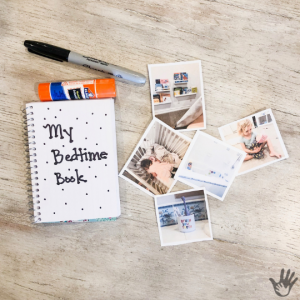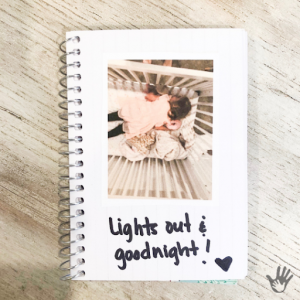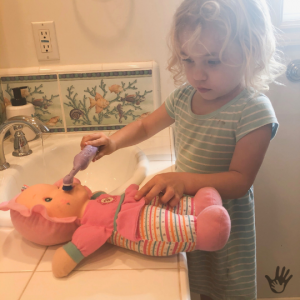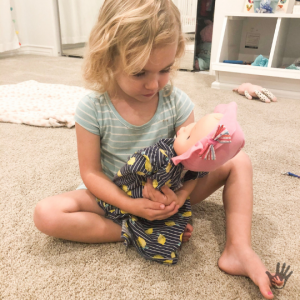We are so excited to team up with Lauren in this guest blog post. In this article, we will take Lauren’s recommendations and show you how to practice and work toward a consistent, predictable bedtime routine using a visual schedule and of course… PLAY!
Lauren recommends the following bedtime routine for kiddos ages ~2-5 years old:
- Bath/Shower
- Pajamas, brush teeth, bathroom
- Read Books
- Massage/breathing
- Lights out and goodnight
You can find her guest blog post here on our website, where she explains this in detail.
When beginning a desired schedule with your child in this age range, one of the most effective tools to use is a visual schedule. A visual schedule makes the plan of events more concrete and understandable for little ones, preparing them for activities by allowing them to see what activity needs to be completed and what to expect next.

Here we used a small index card book and glued pictures of our kiddo performing the actions.
You can include pictures of each activity (little ones love to see themselves in these pictures!) and either have your kiddo pull off the pictures as the events occur, or leave them in order to reference time concepts, such as “first” and “then.”
For bedtime, it may also be beneficial to put it in a small “Bedtime Book”. That way, they can hold onto it and flip through it as they perform each step with your help.
Another great way to introduce new routines is to practice through play! Using toys and props to take your kiddo through the steps of a routine is a fun way for them to learn what to expect and to increase their understanding of why and how each new event is taking place.

One of our favorite toys to use to practice bedtime routines is a doll (or a favorite stuffed animal).
The following are some examples of how a doll can be used to help little ones understand expectations of the bedtime routine through play:
Does your child resist brushing their teeth? You are not alone! Pretend play using a doll is a fun way to help them through this process.

You can guide your child through talking to their doll while taking them through each step (e.g., “First we put this yummy toothpaste on, then we get the toothbrush wet, then we brush brush brush!”).
This is also a great opportunity to help your child explain to their doll why we need to brush our teeth, while increasing their own understanding (e.g., “Let’s help Dolly take care of her body. We need to brush her teeth to keep them strong and healthy”).
Make it even more fun by singing a song while you brush (e.g., “This is the Way We Brush Our Teeth”)! If your little one seems to need more support and structure, try using a fun visual timer to make the concept of “brushing time” more clear and concrete.
Your kiddo may also enjoy “reading” a favorite book to their doll to practice the bedtime routine! This not only naturally promotes language development, but it is also a great opportunity to set certain expectations by roleplaying with your child.
For example, you can suggest “letting the doll pick one book that she wants to read before bedtime,” then help your kiddo explain to the doll, “We will read this one book, then it’s bedtime.” After your child reads the book, you can pretend to be the doll by requesting, “One more book!”
 Then, depending on the expectations you hope to set, you can provide a response like, “Oh, Dolly really wants one more book but she already picked her one book and it’s bedtime now. Let’s help Dolly pick the book she wants to read in the morning and we’ll put it in a special spot.”
Then, depending on the expectations you hope to set, you can provide a response like, “Oh, Dolly really wants one more book but she already picked her one book and it’s bedtime now. Let’s help Dolly pick the book she wants to read in the morning and we’ll put it in a special spot.”
Your little one can then practice the end of the night routine by putting their doll in bed (something they’ve probably done before)! You can guide them through covering their doll with a blanket and tucking them in, singing a lullaby, giving a kiss, and saying goodnight as they turn out the light.
Talking to your child about why their dolly needs to sleep can be helpful, too (e.g., “Dolly needs to sleep so that she can grow big and strong. We will see her as soon as she wakes up!”).
For more purposeful play ideas and activities to promote development with your child, check out our website!
ABOUT THE AUTHORS
Meet Walk, Talk, Play! Play is the work of children. It is structured or spontaneous, symbolic or abstract. It engages the body and the imagination for the purpose of enjoyment! As pediatric speech, occupational, and physical therapists, Amanda, Shawn, Rhea, and Kim have a passion for enhancing motor skills, sensory processing and language through play. They hope to inspire families, teachers, and therapists through products and activities they love, as well as share resources and research for preschool-aged children (2 years-5 years). Let’s play!
